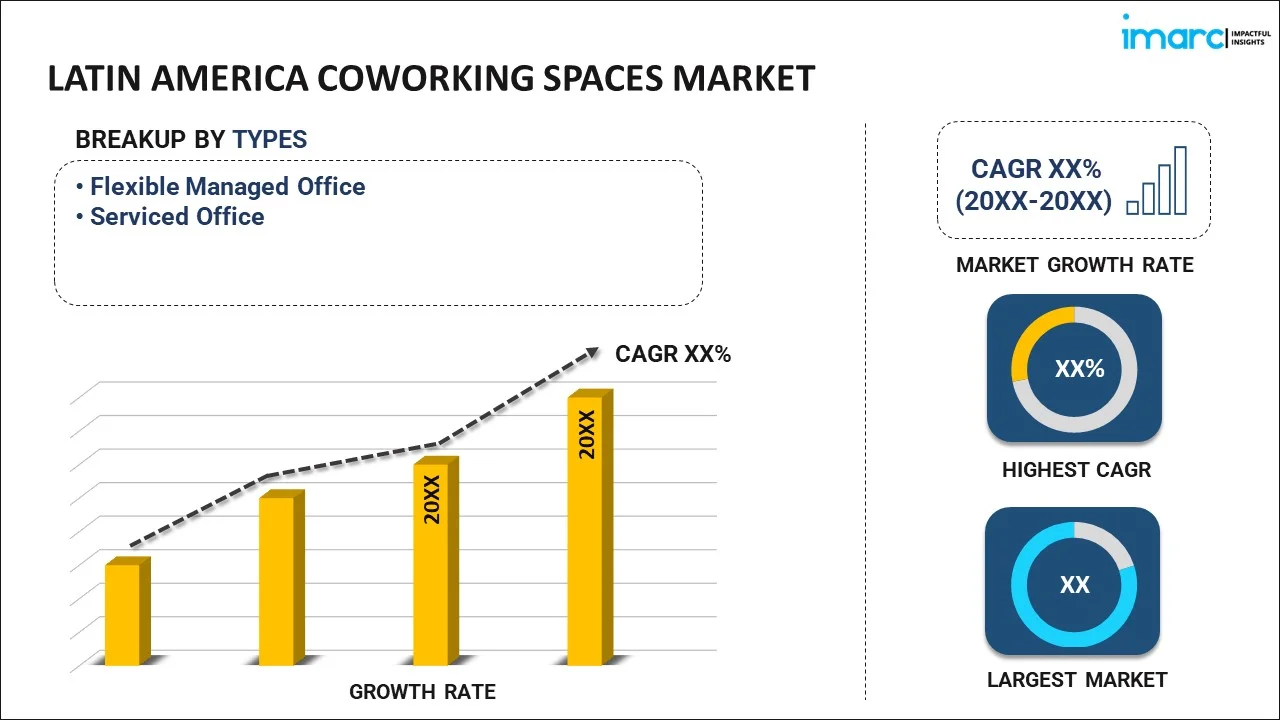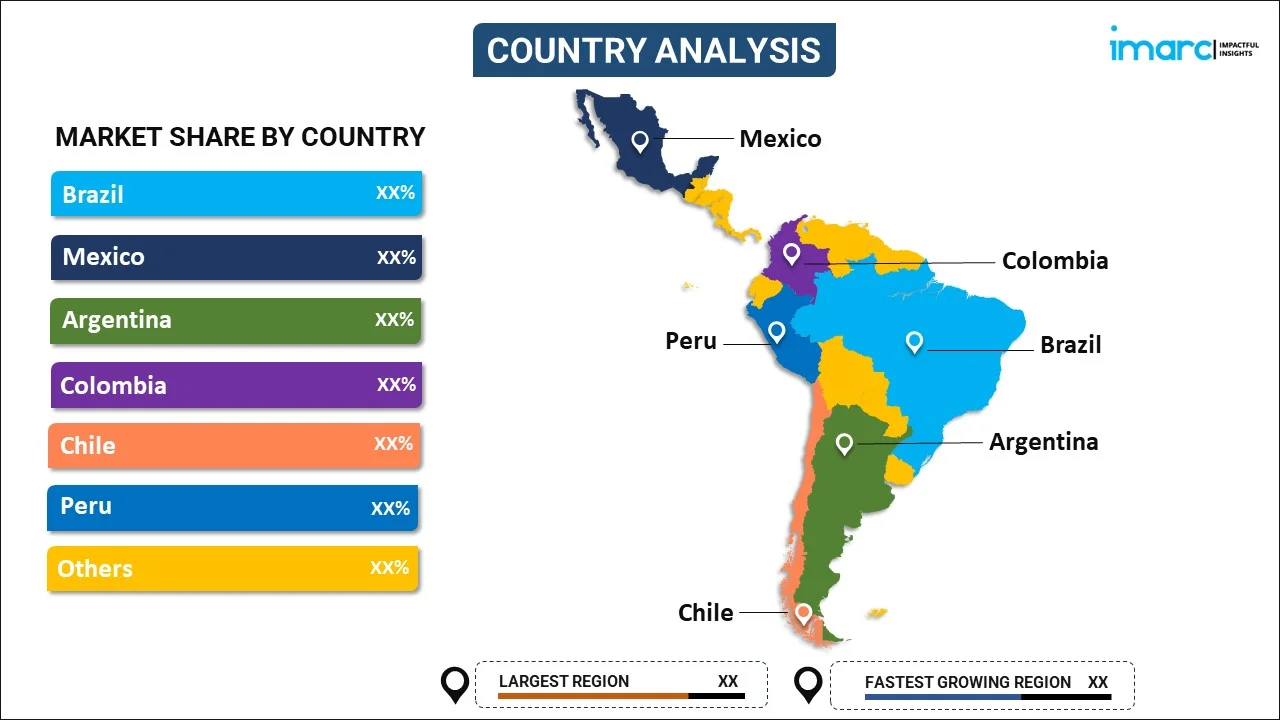
Latin America Coworking Spaces Market Report by Type (Flexible Managed Office, Serviced Office), Business Model (Information Technology (IT and ITES), Legal Services, BFSI (Banking, Financial Services, and Insurance), Consulting and Other Services), End User (Personal User, Small Scale Company, Large Scale Company, and Others), and Country 2025-2033
Market Overview:
Latin America coworking spaces market size reached USD 1.13 Billion in 2024. Looking forward, IMARC Group expects the market to reach USD 3.25 Billion by 2033, exhibiting a growth rate (CAGR) of 11.50% during 2025-2033. The rising focus of businesses across the region on creating culturally resonant yet modern environment is primarily driving the market growth.
|
Report Attribute
|
Key Statistics
|
|---|---|
|
Base Year
|
2024
|
|
Forecast Years
|
2025-2033
|
|
Historical Years
|
2019-2024
|
|
Market Size in 2024
|
USD 1.13 Billion |
|
Market Forecast in 2033
|
USD 3.25 Billion |
| Market Growth Rate 2025-2033 | 11.50% |
Coworking spaces signify a contemporary approach to traditional work settings, presenting a shared workspace where individuals from various professions or companies can collaborate. In contrast to conventional offices, they foster a communal atmosphere, encouraging teamwork, networking, and the sharing of resources. These spaces typically come furnished with essential office amenities, including desks, internet access, meeting rooms, and occasionally cafes or lounges. Coworking spaces cater to freelancers, startups, remote workers, and small teams, offering flexibility without the commitment or overhead costs of a dedicated office. The focus lies in creating a lively, dynamic environment that stimulates creativity, interaction, and collective progress, serving as a platform for both individual productivity and collaborative innovation.
Latin America Coworking Spaces Market Trends:
The coworking spaces market in Latin America is experiencing significant transformations propelled by key factors and emerging trends. A crucial driver is the escalating demand for a flexible and collaborative work environment. Moreover, as businesses in the region adapt to dynamic market conditions, the need for versatile workspaces catering to freelancers, startups, and remote teams is on the rise. Besides this, green initiatives, energy efficiency, and environmentally conscious features align with the growing emphasis on responsible and sustainable business practices across Latin America. Additionally, technology plays a pivotal role, with co-working spaces leveraging advanced digital tools to enhance connectivity and productivity. Apart from this, from smart access systems to collaborative platforms, these technologies contribute to an efficient and modern work experience. Furthermore, community-building and collaborations are key trends fostering a sense of camaraderie among co-workers. Networking events, workshops, and shared projects create a vibrant ecosystem, promoting knowledge exchange and professional growth. Besides this, government support for entrepreneurship and innovation is further catalyzing the regional market. As such, policymakers recognize the economic advantages of nurturing collaborative workspaces, leading to increased initiatives and backing for the development of co-working ecosystems in Latin America. In conclusion, these drivers and trends collectively shape a responsive and innovative coworking landscape in the region, which will continue to augment the market growth over the forecasted period.
Latin America Coworking Spaces Market Segmentation:
IMARC Group provides an analysis of the key trends in each segment of the market, along with forecasts at the regional and country levels for 2025-2033. Our report has categorized the market based on type, business model, and end user.
Type Insights:

- Flexible Managed Office
- Serviced Office
The report has provided a detailed breakup and analysis of the market based on the type. This includes flexible managed office and serviced office.
Business Model Insights:
- Information Technology (IT and ITES)
- Legal Services
- BFSI (Banking, Financial Services, and Insurance)
- Consulting and Other Services
A detailed breakup and analysis of the market based on the business model have also been provided in the report. This includes information technology (IT and ITES), legal services, BFSI (banking, financial services, and insurance), and consulting and other services.
End User Insights:
- Personal User
- Small Scale Company
- Large Scale Company
- Others
The report has provided a detailed breakup and analysis of the market based on the end user. This includes personal user, small scale company, large scale company, and others.
Country Insights:

- Brazil
- Mexico
- Argentina
- Colombia
- Chile
- Peru
- Others
The report has also provided a comprehensive analysis of all the major regional markets, which include Brazil, Mexico, Argentina, Colombia, Chile, Peru, and Others.
Competitive Landscape:
The market research report has also provided a comprehensive analysis of the competitive landscape in the market. Competitive analysis such as market structure, key player positioning, top winning strategies, competitive dashboard, and company evaluation quadrant has been covered in the report. Also, detailed profiles of all major companies have been provided.
Latin America Coworking Spaces Market Report Coverage:
| Report Features | Details |
|---|---|
| Base Year of the Analysis | 2024 |
| Historical Period | 2019-2024 |
| Forecast Period | 2025-2033 |
| Units | Billion USD |
| Scope of the Report | Exploration of Historical Trends and Market Outlook, Industry Catalysts and Challenges, Segment-Wise Historical and Future Market Assessment:
|
| Types Covered | Flexible Managed Office, Serviced Office |
| Business Models Covered | Information Technology (IT and ITES), Legal Services, BFSI (Banking, Financial Services, and Insurance), Consulting and Other Services |
| End Users Covered | Personal User, Small Scale Company, Large Scale Company, Others |
| Countries Covered | Brazil, Mexico, Argentina, Colombia, Chile, Peru, Others |
| Customization Scope | 10% Free Customization |
| Post-Sale Analyst Support | 10-12 Weeks |
| Delivery Format | PDF and Excel through Email (We can also provide the editable version of the report in PPT/Word format on special request) |
Key Questions Answered in This Report:
- How has the Latin America coworking spaces market performed so far and how will it perform in the coming years?
- What has been the impact of COVID-19 on the Latin America coworking spaces market?
- What is the breakup of the Latin America coworking spaces market on the basis of type?
- What is the breakup of the Latin America coworking spaces market on the basis of business model?
- What is the breakup of the Latin America coworking spaces market on the basis of end user?
- What are the various stages in the value chain of the Latin America coworking spaces market?
- What are the key driving factors and challenges in the Latin America coworking spaces?
- What is the structure of the Latin America coworking spaces market and who are the key players?
- What is the degree of competition in the Latin America coworking spaces market?
Key Benefits for Stakeholders:
- IMARC’s industry report offers a comprehensive quantitative analysis of various market segments, historical and current market trends, market forecasts, and dynamics of the Latin America coworking spaces market from 2019-2033.
- The research report provides the latest information on the market drivers, challenges, and opportunities in the Latin America coworking spaces market.
- Porter's five forces analysis assist stakeholders in assessing the impact of new entrants, competitive rivalry, supplier power, buyer power, and the threat of substitution. It helps stakeholders to analyze the level of competition within the Latin America coworking spaces industry and its attractiveness.
- Competitive landscape allows stakeholders to understand their competitive environment and provides an insight into the current positions of key players in the market.
Need more help?
- Speak to our experienced analysts for insights on the current market scenarios.
- Include additional segments and countries to customize the report as per your requirement.
- Gain an unparalleled competitive advantage in your domain by understanding how to utilize the report and positively impacting your operations and revenue.
- For further assistance, please connect with our analysts.
 Inquire Before Buying
Inquire Before Buying
 Speak to an Analyst
Speak to an Analyst
 Request Brochure
Request Brochure
 Request Customization
Request Customization




.webp)




.webp)












